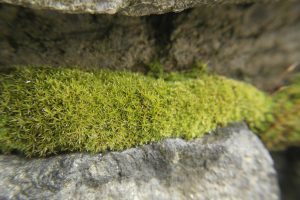Kirjoittaja on trooppisen ekologian tutkija, jonka sydämessä on erityinen paikka sammalille. Jatko-opiskelijan arkea tasapainottavat huonekasviviidakon ylläpito, valokuvaus ja kuonokansalaisen aktivointi.
The writer of this post, Tinja Pitkämäki is a researcher in tropical ecology who has a soft spot for bryophytes. When not working on her PhD, she feels most relaxed maintaining her urban jungle. She also enjoys nature photography and spending time with her dog.
Sammal ei kavahda ikijäätä tai avaruutta
Sammalet ovat kasvimaailman selviytyjiä, jotka asuttavat maapallon karuimpiakin elinympäristöjä. Yhdessä jäkälien kanssa ne valtaavat alaa siellä, missä useimmat putkilokasvit sinnittelevät kitukasvuisina yksilöinä.
Arktisella tundralla sammalet ja jäkälät peittävät maanpintaa seuralaisinaan erilaiset varvut, heinät ja sarat. Mitä karumpi elinympäristö, sitä silmiinpistävämpi on sammalten valta-asema: Etelämantereella esiintyy luontaisesti vain kaksi koppisiemenisiin eli kukkakasveihin luettavaa lajia, mutta sammalten yhteismäärä yltää 130 lajiin1,2. Osa sammalkasvistosta on todennäköisesti tutkimusmatkailijoiden mukana kulkeutuneita tulokaslajeja.
Vuonna 2014 tutkijat havaitsivat, että vähintään 1500 vuotta ikiroudassa viettänyt sammalverso kykeni uuteen kasvuun3. Kyseinen laji kuuluu kynsisammalten heimoon (Dicranaceae) ja on siten sukua Suomessakin yleisille kynsisammalille (Dicranum-suku).
Sammalten sopeutumiskyky ylittää jopa planeettamme rajat. Kiitos astrobiologien, sammalnäyte toisensa jälkeen on päätynyt maata kiertävälle radalle. NASA-yhteistyönä toteutetussa tutkimuksessa tarkasteltiin kulosammalen (Ceratodon purpureus) kasvua painottomuudessa4. Tutkijat yllättyivät havaitsemastaan, säännöllistä spiraalia muistuttavasta kasvutavasta. Tulos poikkesi aiemmista kasveilla tehdyistä tutkimuksista, joissa kasvu tapahtui epäsäännönmukaisesti. Koska spiraalimainen kasvu vähentää verson osien kilpailua valosta, kyseessä voi olla geneettinen sopeuma, jonka ilmeneminen estyy Maan painovoiman vaikutuksesta. Kööpenhaminan yliopistossa toimiva SpaceMoss-tutkimusryhmä pohtii mielikuvituksellisia tapoja hyödyntää sammalten kestävyyttä. Ryhmän tutkijat toivovat, että geenimanipuloitu nuppusammal (Physcomitrella patens) voisi tulevaisuudessa kasvaa Marsin pinnalla ja tuottaa astronauteille lääkeaineita5.
Mikä mahdollistaa äärioloissa selviytymisen? Kyseeessä on kryptobioosi – eräänlainen horros, jossa eliön normaali aineenvaihdunta pysähtyy ankarissa olosuhteissa. Kryptobioosia esiintyy useilla eliöryhmillä, useimmiten kuivuuden seurauksena. Erilaiset sopeumat kuivuuteen selittävät myös ekologisia eroja sammalten ja putkilokasvien välillä. Karkeasti ottaen voisi sanoa, että putkilokasvit välttelevät kasvisolujen kuivumista, kun taas sammalet sietävät sitä. Sammaliin verrattuna putkilokasvien solukot ovat erikostuneempia tiettyyn tehtävään, kuten varastoimaan vettä tai ehkäisemään haihtumista. Rakenteellinen yksikertaisuus näyttäisikin olevan useimpia äärioloissa selviytyviä eliöitä yhdistävä ominaisuus.
Surviving permafrost and space – is there anything bryophytes can’t handle?
Bryophytes are the survivors of the plant kingdom. Together with lichens, they flourish where most vascular plants struggle to stay alive.
Bryophytes can be found in the Arctic tundra, where they cover the ground accompanied with different kinds of shrubs, grasses and sedges. Yet the dominance of bryophytes is most striking in the harshest of habitats: while only two species of flowering plants (Antarctic hair grass, Deschampsia antarctica, and Antarctic pearlwort, Colobanthus quitensis) naturally occur in the Antarctic, the number of bryophyte species reported totals 1301,2! Some species, however, are most likely introduced by explorers.
In 2014, researchers witnessed the revival of a bryophyte shoot that had been deposited in permafrost for at least 1,500 years3. The particular species, belonging to the Dicranaceae-family, is a relative of fork mosses (genus Dicranum), which typically occur in the forests of Finland.
Bryophytes’ ability to adapt even exceeds the boundaries of our planet and thanks to astrobiologists, bryophyte specimens after one another have ended up orbiting the Earth!In an experiment conducted in collaboration with NASA, researchers investigated the growth of purple forkmoss (Ceratodon purpureus) in zero gravity. They were surprised to observe a spiral-like pattern, as random growth was expected based on previous research. Spiraling growth reduces competition over light within shoots, pointing towards a genetic adaptation that becomes unnoticeable when the plant is exposed to Earth’s gravitational force. At University of Copenhagen, a research group named “SpaceMoss” is thinking of innovative ways to utilize bryophytes’ hardiness, hoping that in the future, genetically modified spreading earthmoss (Physcomitrella patens) would grow on the surface of Mars and produce medicinal compounds for astronauts5.
What makes it possible for organisms to survive such harsh environments? It is a state resembling hibernation, cryoptobiosis, which allows for ceasing metabolism in extreme conditions. Cryptobiosis occurs in multiple groups of organisms, and is usually associated with extreme drought. Adaptation to drought also explains ecological differences between bryophytes and vascular plants. As a coarse generalization, one could say that vascular plants avoid desiccation at cell level, whereas bryophytes tolerate it. In comparison to bryophytes, the tissues of vascular plants are more specialized to certain tasks, such as water storage or preventing evaporation. It appears that being structurally simple is the key for organisms exhibiting the ability for ultimate survival.
References:
1) Ochyra R., Lewis Smith R.I. & Bednarek-Ochyra H. 2008. The illustrated moss flora of Antarctica. Cambridge University Press, Cambridge, UK. 704 pp.
2) Bednarek-Ochyra H., Váňa J., Ochyra R. & Lewis Smith R.I. 2000. The liverwort flora of Antarctica. Institute of Botany, Polish Academy of Sciences, Cracow, Poland. 236 pp.
3) Roads E., Longton R.E. & Convey P. 2014. Millennial timescale regeneration in a moss from Antarctica. Current Biology 24(6): R222–R223.
4) Kern V.D., Schwuchow J.M., Reed D.W., Nadeau J.A. Lucas J., Skripnikov A. & Sack F.D. 2005. Gravitropic moss cells default to spiral growth on the clinostat and in microgravity during spaceflight. Planta 221(1): 149–157.
5) Elena Knuth-Pollock, Life on Mars – attempt to grow moss in space. An article published on the University of Copenhagen website 17.6.2015, read 14.1.2015. Link:
http://universitypost.dk/article/life-mars-attempt-grow-moss-space

